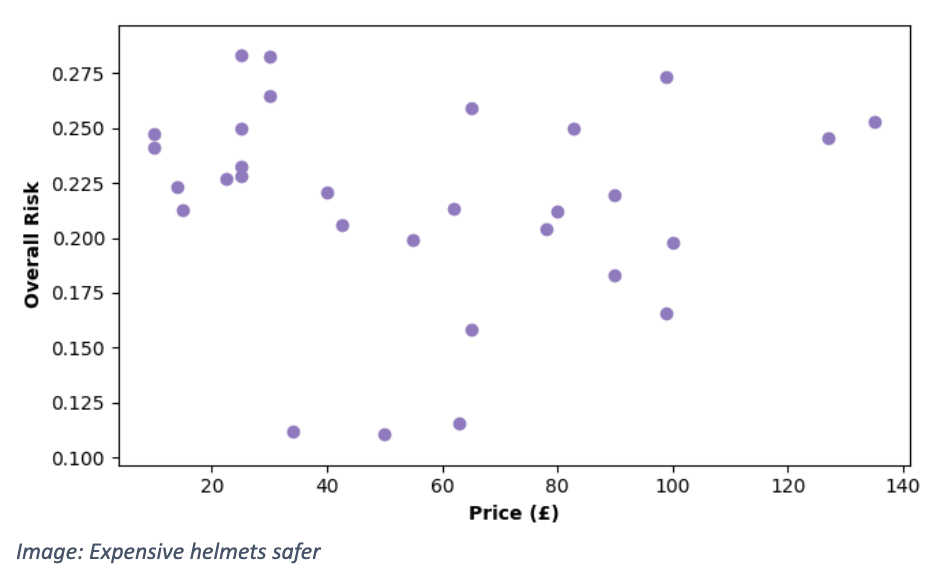FAQs
In the first round of rating, we tested 30 different helmet models. This limited number was imposed by the budget and time constraints. However, we selected the most popular bicycle helmets used by UK cyclists. Our selection was based on an extensive search of major retailers’ websites and a survey of cyclists, which attracted over 1,100 responses. We aim to extend the rating to include more helmet models.
No. In our first set of ratings, helmets ranging from £9.99 to £135.00 were tested. The analysis of these data showed no correlation between price and overall risk, as can be seen in this figure. The image is from our paper published in Annals of Biomedial Engineering: https://link.springer.com/article/10.1007/s10439-024-03589-8.
There is a fundamental difference between standards and rating systems. Standards are designed to ensure a minimum level of safety before helmets can enter the market. Standards however cannot differentiate between the safety of different helmets. This is the information that rating systems can provide. They differentiate between helmets in terms of their safety. Another difference is that standards are often very slow in improving their methods to reflect the evidence provided by research and data. A clear example is measuring head rotation as an injury criterion. There has been overwhelming biomechanics evidence showing that head rotation is a key cause of brain injuries, but only one motorcycle helmet standard has adopted the use of head rotation as an injury criterion. Rating systems can be more agile and, if supported by enough resources, can incorporate state-of-the-art research and data into their rating methods. A good example is the European New Car Assessment Programme (EuroNCAP), which is rapidly responding to the changes in the automotive industry, such as the introduction of automated driver assistance systems.
The short answer is that we cannot. This is because we cannot test a helmet under all possible impact conditions. This requires many helmets and test time, which makes the assessment impossible. However, we can test helmets under conditions that most frequently occur in the real world. We have reviewed many studies that provided data for bicycle incidents to determine the most likely head impact conditions, including the location of impact on the helmet, the angle of impact, impact speed and the shape of the struck surface. We have published the results of this review in Annals of Biomedical Engineering: https://link.springer.com/article/10.1007/s10439-023-03148-7. Access to more high-quality data and professional resources for analysing them will allow us to improve the test conditions.
Users of this site should be aware that the safety ratings are derived solely from the outcomes and findings from the relevant team’s Methodology as explained in Our Methodology, which was conducted in 2022-23, and the open-access peer-reviewed journal publication https://link.springer.com/article/10.1007/s10439-024-03589-8. Although helmets were tested under conditions that represent real-world cycle incidents, no helmet can protect the brain, head or neck in respect of all possible accidents or incidents. For the avoidance of doubt, neither Imperial College London, nor ay of its affiliates, nor the publisher of this website assume any responsibility or liability for any errors or omissions in the content of this site or in the findings or methodology. The information contained in this site is provided on an “as is” basis with no guarantees of completeness or accuracy.
